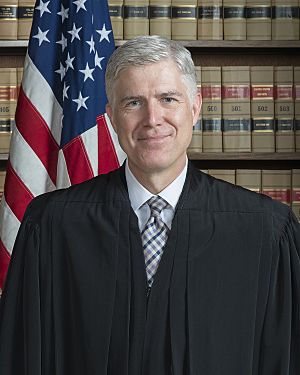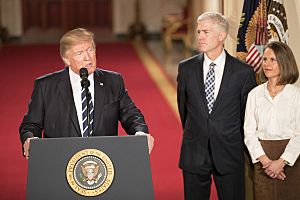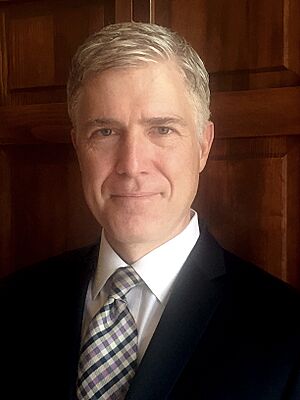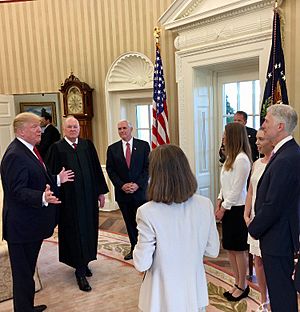Neil Gorsuch facts for kids
Quick facts for kids
Neil Gorsuch
|
|
|---|---|

Official portrait, 2017
|
|
| Associate Justice of the Supreme Court of the United States | |
| Assumed office April 10, 2017 |
|
| Nominated by | Donald Trump |
| Preceded by | Antonin Scalia |
| Judge of the United States Court of Appeals for the Tenth Circuit | |
| In office August 8, 2006 – April 9, 2017 |
|
| Nominated by | George W. Bush |
| Preceded by | David M. Ebel |
| Succeeded by | Allison H. Eid |
| Principal Deputy Associate Attorney General |
|
| In office June 2005 – July 2006 |
|
| Attorney General | John Ashcroft |
| Personal details | |
| Born |
Neil McGill Gorsuch
August 29, 1967 Denver, Colorado, U.S. |
| Spouse |
Louise Burleston
(m. 1996) |
| Children | 2 |
| Education | |
| Signature | |
| Scientific career | |
| Thesis | (2004) |
| Doctoral advisor | John Finnis |
| Other academic advisors | Timothy Endicott |
Neil McGill Gorsuch (born August 29, 1967) is an American judge. He is an associate justice on the highest court in the United States. President Donald Trump chose him for this role on January 31, 2017. He has been serving since April 10, 2017.
Gorsuch grew up in Denver, Colorado. He went to Columbia University and became a good writer. Later, he studied law at Harvard Law School. He also earned a special law degree from Oxford University in 2004. He was a Marshall Scholar there.
Before becoming a judge, Gorsuch worked for several important judges. He was a law clerk for Judge David B. Sentelle and for Supreme Court Justices Byron White and Anthony Kennedy. From 1995 to 2005, Gorsuch worked at a private law firm. He also worked for the United States Department of Justice from 2005 to 2006.
President George W. Bush then nominated Gorsuch to be a judge on the United States Court of Appeals for the Tenth Circuit. This happened on May 10, 2006. Gorsuch believes in interpreting laws and the United States Constitution based on their original meaning. He is the first Supreme Court justice to serve with a justice he once worked for (Justice Kennedy).
During his time on the Supreme Court, he has written important decisions. These include cases about LGBT rights (Bostock v. Clayton County), Native American law (McGirt v. Oklahoma), and religious freedom (Kennedy v. Bremerton School District).
Contents
Early Life and Education
Gorsuch was born in Denver, Colorado, on August 29, 1967. His parents, Anne Gorsuch Burford and David Ronald Gorsuch, were both lawyers. He was the oldest of three children. His family has lived in Colorado for many generations.
His mother, Anne Gorsuch Burford, was a member of the Colorado House of Representatives. In 1981, President Ronald Reagan appointed her to lead the U.S. Environmental Protection Agency. She was the first woman to hold this position. When his mother took this job, Gorsuch's family moved to Bethesda, Maryland.
He attended Georgetown Preparatory School, a private school. There, he was two years younger than Brett Kavanaugh. Both later became Supreme Court justices. Gorsuch also worked as a Senate page in the early 1980s. He finished high school in 1985.
After high school, Gorsuch went to Columbia University. He graduated in 1988 with a degree in political science. He was a very good student. While at Columbia, he wrote for the student newspaper, Columbia Daily Spectator. He also helped start another student newspaper called The Fed.
Gorsuch then went to Harvard Law School. He received a special scholarship to attend. He was known as a conservative student. He supported the Gulf War and wanted limits on how long members of Congress could serve. Barack Obama, who later became president, was one of his classmates. Gorsuch graduated from Harvard Law in 1991.
In 2004, Gorsuch earned another degree, a Doctor of Philosophy in law, from the University of Oxford in England. He studied there with a Marshall Scholarship. His main teacher was John Finnis, a philosopher who studied natural law. In 1996, Gorsuch married Louise, an Englishwoman he met at Oxford.
Early Legal Career
Working for Judges
After law school, Gorsuch worked for Judge David B. Sentelle from 1991 to 1992. This was at the United States Court of Appeals for the District of Columbia Circuit. After studying at Oxford, Gorsuch worked for Supreme Court Justices Byron White and Anthony Kennedy from 1993 to 1994.
He helped Justice White with his work on the Tenth Circuit after White retired from the Supreme Court. Gorsuch was part of a group of five law clerks that year. One of them was Brett Kavanaugh, who later became a Supreme Court justice with Gorsuch.
Working in Private Law
From 1995 to 2005, Gorsuch worked at a law firm called Kellogg, Huber, Hansen, Todd, Evans & Figel. He focused on trial cases. His clients included a Colorado billionaire named Philip Anschutz. Gorsuch worked on cases involving contracts, antitrust, and securities fraud.
In 2002, Gorsuch wrote an article criticizing the Senate. He said they were unfairly delaying the approval of judges like Merrick Garland and John Roberts. He felt that "the most impressive judicial nominees are grossly mistreated" by the Senate.
In 2005, Gorsuch wrote a legal document about class action lawsuits. These are lawsuits where many people join together against a company. He believed these lawsuits cost businesses billions of dollars each year.
Working for the U.S. Government
Gorsuch worked for the United States Department of Justice from 2005 to 2006. He was a main deputy to the Associate Attorney General, Robert McCallum. He helped manage the department's civil cases.
He also helped with cases related to the "War on Terror". He defended the government's actions in some cases. He also visited the Guantanamo Bay detention camp in 2005.
U.S. Court of Appeals for the Tenth Circuit (2006–2017)
In 2006, President George W. Bush nominated Gorsuch to be a judge on the United States Court of Appeals for the Tenth Circuit. This court hears appeals from federal courts in several states. The American Bar Association gave him its highest rating, calling him "well qualified."
On July 20, 2006, the U.S. Senate approved Gorsuch by a unanimous vote. He was the fifth judge Bush appointed to the Tenth Circuit. Justice Kennedy, whom Gorsuch had clerked for, swore him into office.
While on the Tenth Circuit, Gorsuch was known as a "feeder judge." This means many of his law clerks went on to work for Supreme Court justices.
Religious Freedom Cases
Gorsuch believes in a wide definition of religious freedom. In one case, Pleasant Grove City v. Summum (2007), he agreed that a city did not have to display every religious monument if it already had a Ten Commandments monument. He has written that the law protects "unpopular religious beliefs."
How Government Agencies Interpret Laws
Gorsuch has questioned a rule called Chevron U.S.A., Inc. v. Natural Resources Defense Council, Inc. (1984). This rule says that courts should usually agree with how government agencies interpret unclear laws. Gorsuch believes judges should decide what laws mean, not agencies. He wrote that this rule is "more than a little difficult to square with the Constitution."
Rules About Trade Between States
Gorsuch has also looked at rules about trade between states. In 2011, he agreed that Oklahoma Water Resources Board could stop water from being sent to Texas. In 2015, he ruled that Colorado's rules for renewable energy did not unfairly hurt out-of-state coal companies.
Nomination to the Supreme Court

During the 2016 United States presidential election, Donald Trump said Gorsuch was one of the judges he would consider for the Supreme Court. After Trump became president, he announced Gorsuch as his choice on January 31, 2017. Gorsuch was 49 years old, making him one of the youngest nominees in a long time.
Gorsuch called Merrick Garland, who was President Obama's choice for the same position. Garland's nomination had not been considered by the Senate. The American Bar Association again gave Gorsuch its highest rating. His confirmation hearing began on March 20, 2017.
On April 3, the Senate Judiciary Committee approved his nomination. On April 6, 2017, some senators tried to block the vote. However, Republicans used a special rule called the "nuclear option." This allowed the vote to go forward with a simple majority.
On April 7, 2017, the Senate confirmed Gorsuch by a vote of 54–45. Three Democrats voted with all Republicans to approve him. Gorsuch was sworn into office on April 10, 2017. He became the 101st associate justice of the Supreme Court.
U.S. Supreme Court (2017–Present)
Gorsuch's time on the Supreme Court has been noted for his unique writing style. Some describe his rulings as those of "a wild card" because he doesn't always agree with traditional views. He is sometimes called the "most libertarian" justice on the court.
He has also been seen as a justice who addresses "historical injustice." This is especially true in cases involving Native Americans and tribal law. Gorsuch is also known for being fair to people accused of crimes. He has often sided with criminal defendants.
Banking Rules
Gorsuch wrote his first Supreme Court decision in Henson v. Santander Consumer USA Inc. (2017). The Court decided that a company that buys old debts is not a "debt collector" under a specific law. This meant the company did not have to follow certain rules.
First Amendment Rights
Gorsuch has joined decisions that protect compelled speech. This means the government cannot force people to say things they don't believe.
He wrote the main opinion in Kennedy v. Bremerton School District (2022). This case was about a public high school football coach who prayed on the field. The Court said the coach's actions were protected by the First Amendment. This amendment protects freedom of speech and religion.
Gorsuch also wrote the main opinion in 303 Creative LLC v. Elenis (2023). This case involved a web designer who wanted to create wedding websites only for opposite-sex weddings. The Court ruled that her freedom of speech allowed her to do this, even though a state law prohibited discrimination based on sexual orientation.
LGBT Rights
In 2020, Gorsuch wrote the main opinion in Bostock v. Clayton County. This important ruling said that businesses cannot discriminate against LGBTQ people in employment. The decision was 6–3. Gorsuch was joined by Chief Justice Roberts and the four justices usually seen as more liberal.
Rules About Vague Laws
Gorsuch has supported the idea that laws must be clear. If a law is too vague, it can be unconstitutional. In Sessions v. Dimaya (2018), he agreed that a part of an immigration law was too vague. He also wrote the Court's opinion in United States v. Davis (2019), striking down another vague law.
Native American Law and Relations
Gorsuch is seen as an expert on American Indian law. Since joining the Supreme Court, he has often supported tribal rights. Many Native American groups supported his appointment.
In March 2019, Gorsuch joined a majority decision in Washington State Dept. of Licensing v. Cougar Den, Inc. The Court sided with the Yakama Nation. They said a Washington state tax on gasoline violated an 1855 treaty. Gorsuch wrote that the state was trying to get "more" than what was agreed upon in the treaty.
In May 2019, Gorsuch again sided with Native Americans in Herrera v. Wyoming. This case was about hunting rights granted to the Crow people by an 1868 treaty. The Court ruled that these rights were still valid, even after Wyoming became a state.
In July 2020, Gorsuch wrote the main opinion in McGirt v. Oklahoma. This landmark case decided that a large part of eastern Oklahoma is still "Indian country." This means that crimes committed by Native Americans against other Native Americans on tribal land are under the jurisdiction of Native Courts. Gorsuch wrote that the government must "hold to its word" from old treaties.
This case was later reviewed in Oklahoma v. Castro-Huerta (2022). The Court decided that both tribal and state/federal governments can have jurisdiction over crimes committed by non-Natives against Natives on tribal land. Gorsuch disagreed with this decision.
On June 15, 2022, Gorsuch ruled in favor of Native American Tribes in Texas in Ysleta del Sur Pueblo v. Texas. The case was about whether Texas could control gambling on Texan Native American reservations. The Court ruled that the tribes could regulate electronic bingo games on their land.
COVID-19 Rules
On November 26, 2020, Gorsuch joined a majority opinion in Roman Catholic Diocese of Brooklyn v. Cuomo. This decision stopped some COVID-19 rules in New York that affected places of worship.
In May 2023, Gorsuch spoke about a lawsuit regarding a policy to prevent COVID-19 cases from entering the U.S. He said that since March 2020, the country might have seen "the greatest intrusions on civil liberties in the peacetime history of this country."
Legal Philosophy
Gorsuch believes in originalism. This means he thinks the Constitution should be understood as it was when it was first written. He also believes in textualism. This means he interprets laws based on their exact words, not on what lawmakers might have intended. Some also say his decisions are influenced by natural law philosophy.
In 2019, some observers noted an "unexpected civil libertarian alliance" between Gorsuch and Justice Sotomayor. They sometimes agree on protecting strong due process rights and being cautious about law enforcement overreach.
How Judges Should Act
In a 2016 speech, Gorsuch said judges should apply the law as it is. They should look at the text, structure, and history of the law. They should not make decisions based on their own beliefs or what they think would be best for society.
In a 2005 article, Gorsuch wrote that some people rely too much on courts to make social changes. He argued that this is "bad for the nation and bad for the judiciary." He believes that social changes should come from elected leaders and public debate.
State Power
A law professor named Justin Marceau has described Gorsuch as a judge who often favors state power over federal power. This can be important in civil rights cases, where federal laws are sometimes used to challenge state laws.
Personal Life
Gorsuch and his wife, Marie Louise Gorsuch, met in England. She is British. They got married in 1996. They live in Boulder, Colorado, and have two daughters.
Gorsuch enjoys outdoor activities like fly fishing. He used to go fishing with Justice Scalia. He also raises horses, chickens, and goats. He often organizes ski trips with his friends and colleagues.
He has co-authored legal books. In 2016, he helped write The Law of Judicial Precedent. In 2024, he co-wrote Over Ruled: The Human Toll of Too Much Law, which discusses too many rules and mass incarceration.
In 2017, after he was nominated to the Supreme Court, it was reported that Gorsuch owned a vacation property with people connected to Philip Anschutz. He later sold this property. In 2023, it was revealed that he sold the property to Brian Duffy, the CEO of a law firm that has cases before the Supreme Court. Gorsuch did not name the buyer on his public forms.
Gorsuch has been active in several professional groups. These include the American Bar Association and various state bar associations. In 2019, he became the new chairman of the board of the National Constitution Center.
Religion
Gorsuch was the first member of a major Protestant church to serve on the Supreme Court since 2010. He and his siblings were raised Catholic and attended weekly church services. His wife, Louise, was raised in the Church of England.
When they moved back to the United States, they joined an Episcopal church in Virginia. Gorsuch volunteered there. Later, his family attended an Episcopal church in Boulder, Colorado. During his confirmation hearing, Gorsuch said he attends an Episcopal church with his family.
See also
 In Spanish: Neil Gorsuch para niños
In Spanish: Neil Gorsuch para niños
- Donald Trump judicial appointment controversies
- List of law clerks of the Supreme Court of the United States (Seat 1)
- List of law clerks of the Supreme Court of the United States (Seat 6)
Videos
- Law's Irony lecture as given at the Federalist Society (video 29 min.) YouTube.



